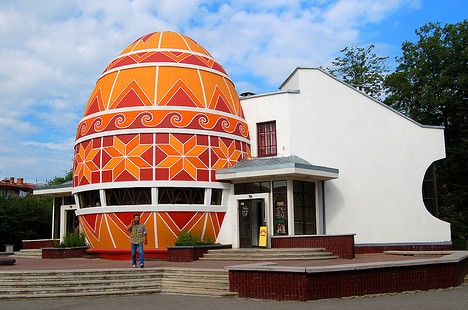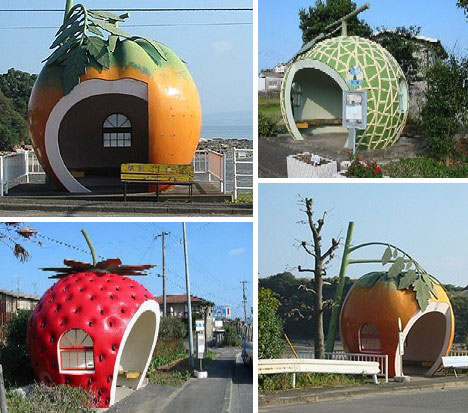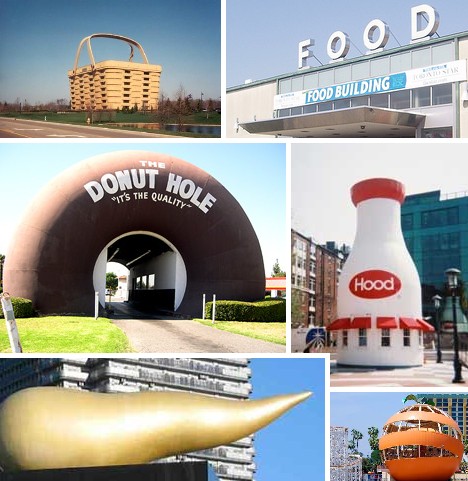
Hungry for some “tasteful” architecture? These 10 mouth-watering buildings may look delicious but their designs serve a greater purpose: to project a brand image that warms the heart (while aiming for the stomach).
Asahi Beer Hall, Tokyo, Japan
 (images via: Arch/Cside and CIDA)
(images via: Arch/Cside and CIDA)
Rising from the shores of the languidly flowing Sumida river in Tokyo, Japan, are a pair of homages to another life-giving liquid: beer. Not only do the Azumabashi Hall and the taller Asahi Breweries Head Office look like glasses of beer, they are the center of the Asahi Breweries empire located on the spot where one of Japan’s signature beers has been brewed for over a century.
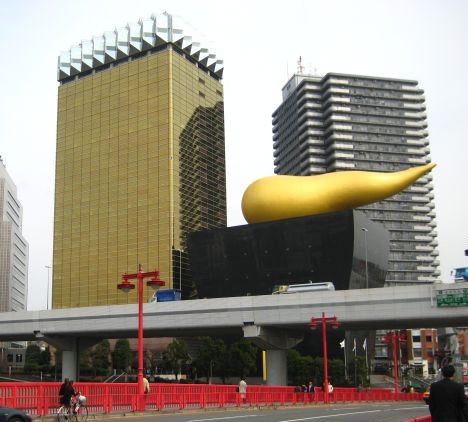 (images via: Tokyo Architecture and Lone Wolf – No Cub)
(images via: Tokyo Architecture and Lone Wolf – No Cub)
It’s the Azumabashi Hall, also known as the Asahi Super Dry Hall, that gets the lion’s share of attention however. Designed by architect Phillippe Starck and completed in 1989, the building is sheathed in black granite puntuated by portaholes representing bubbles rising in a mug of beer. The controversial Flame d’Or (golden flame) on the roof is, well, open to interpretation. Weighing 300 tons and built by a subcontractor who usually builds submarines, the distinctive sculpture has been likened to foam being blown off a frosty mug of draft, the fiery spirit of Asahi’s employees and… a giant turd.
Disney’s Orange Stinger, Anaheim, CA, USA
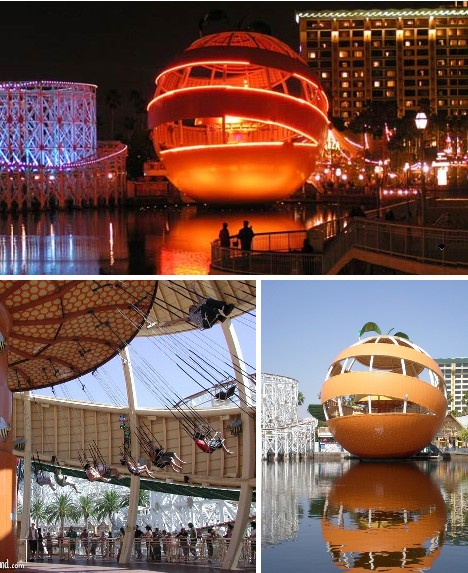 (images via: Desktops@Rocket9, Igougo and Orange County Register)
(images via: Desktops@Rocket9, Igougo and Orange County Register)
More of a ride than a workaday building, the Orange Stinger temporarily brightened up Paradise Pier at Disney’s California Adventure Park from 2001 through July of 2009. The Orange Stinger was a lot bigger than it looked from a distance as essentially it was a standard Wave Swinger style ride with a huge, semi-peeled orange built around it.
Albion House, Liverpool, UK
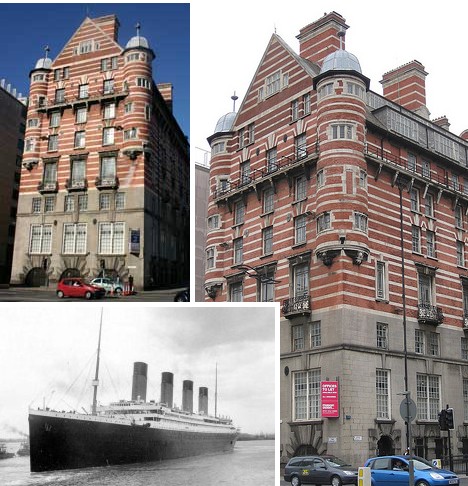 (images via: National Museums Liverpool and Vintage Lulu)
(images via: National Museums Liverpool and Vintage Lulu)
Formerly the White Star Line Building where the RMS Titanic and her sister ships were conceived and controlled, Liverpool’s Albion House (built 1896) sports a trendy for its time red brick & white Portland stone exterior that reminds even the most unsavory character of fresh, streaky bacon. Mmm, bacon… it’s a pity the mighty Titanic wasn’t covered in this most meme-tastic of foods; it would have slid right on past that fateful iceberg.
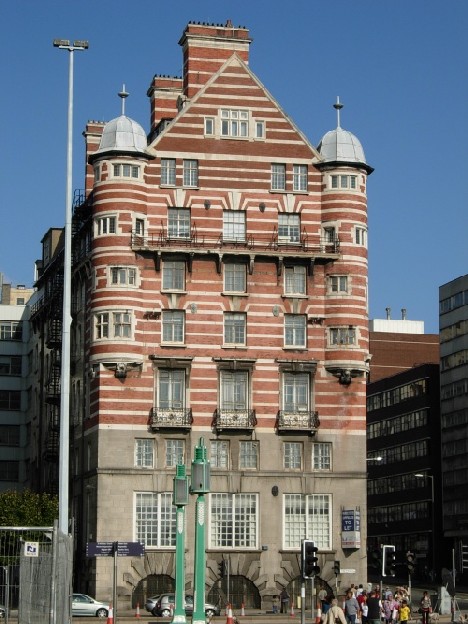 (image via: Pictures Of England)
(image via: Pictures Of England)
Just like the state-of-the-art ships it directed across the seven seas, the White Star Line’s headquarters was a showcase of wealth, opulence and beauty. The shipping line never really recovered from the sinking of the Titanic in 1912 and by the mid-1930s the headquarters building stood vacant. It’s a testament to the foresight of Liverpool’s city fathers that this iconic building remains standing today.
Hood Milk Bottle Building, Boston, MA, USA
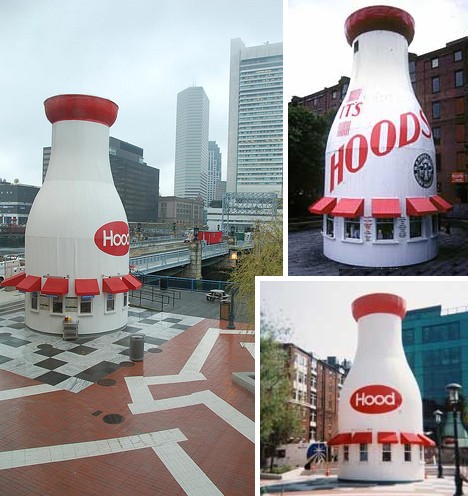 (images via: Chris Devers and Roadside America)
(images via: Chris Devers and Roadside America)
The 40-ft tall Hood Milk Bottle has stood proudly in front of the Boston Children’s Museum since 1977 but its history actually goes back to 1933. That’s when Arthur Gagner built the Coney Island style bottle to sell homemade ice cream beside his store in Taunton, MA. The building sat empty and abandoned from 1967 to 1977 and it’s a wonder it wasn’t destroyed by fire at some point in that lonely decade.
Easter Egg Museum, Ukraine
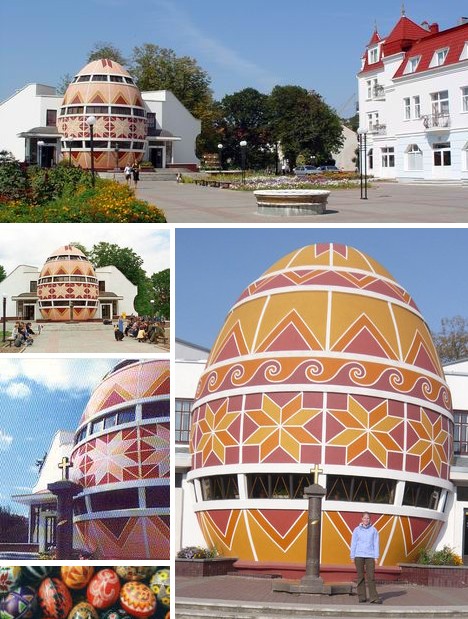 (images via: Travel West Ukraine and Highboom)
(images via: Travel West Ukraine and Highboom)
The Pysanka Museum was built in the year 2000 and is located in the Ukrainian city of Kolomyia. “Pysanka” is the Ukrainian word for richly decorated, batik Easter Eggs and the museum at Kolomyia is the only one in the world dedicated to this important cultural icon. The museum’s central hall measures 46 ft (14m) high by 33 ft (10m) wide, and is designed to resemble a classic Ukrainian Pysanka and is painted in traditional themes inside and out.
The Donut Hole, La Puente, CA, USA
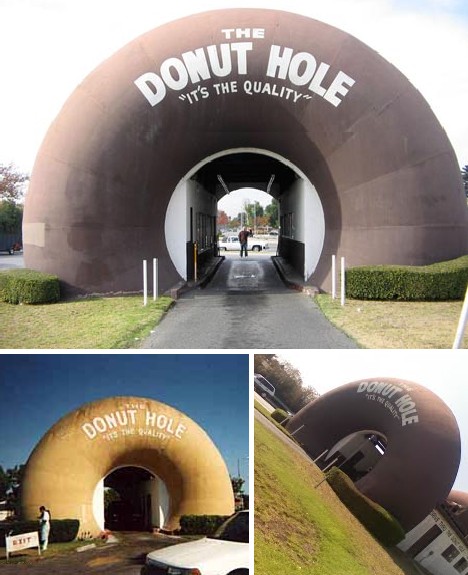 (images via: LA Foodie)
(images via: LA Foodie)
The Donut Hole in La Puente is one of the few remaining examples of programmatic or mimetic architecture left in California, let alone the world. The need to attract newly mobile car-driving customers that arose in the first half of the 20th century has faded now that other advertising venues such as the Internet have taken over.
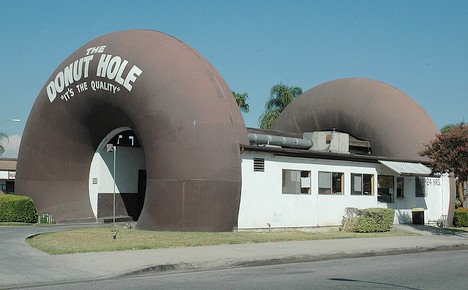 (image via: Wandrlust)
(image via: Wandrlust)
If the concept behind The Donut Hole isn’t surreal enough, how about the actual process of ordering: you literally drive into the unmapped, quantum space that exists inside a giant donut hole. Isn’t that how Voyager wound up 70,000 light years away in the Delta Quadrant?
The Pineapple, Dunmore, Scotland
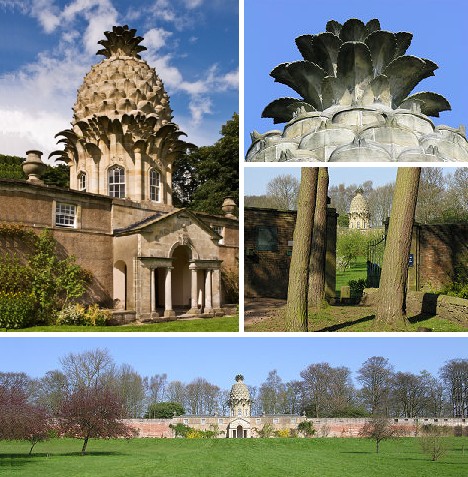 (images via: NorthernXposure, Heritage UK and Undiscovered Scotland)
(images via: NorthernXposure, Heritage UK and Undiscovered Scotland)
Designing buildings that look like food is not a new trend, as The Pineapple in Dunmore, Scotland, proves most eloquently. The pavilion was built in 1761 by John Murray, 4th Earl of Dunmore, as a birthday present for his wife Susan. Judging from the vase-shaped chimneys along the roof of the pavilion, historians assume that many exotic plants were grown in greenhouses just beyond the outer wall. The 53ft tall Pineapple that rises above the pavilion was planned with the utmost care; each leaf drains separately so that seasonal freeze/frost cycles won’t damage the delicate masonry.
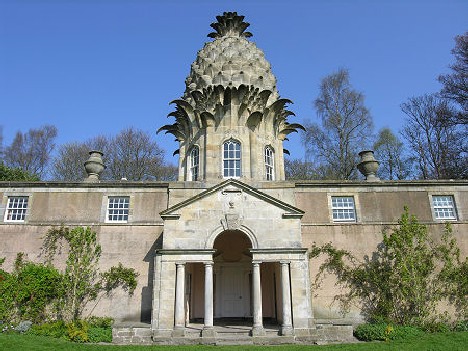 (image via: Undiscovered Scotland)
(image via: Undiscovered Scotland)
As for pineapples in Scotland? Not so strange – though first discovered by Columbus in 1493, pineapples had been grown in Scottish hothouses (a phrase you hear everyday) since the early years of the 18th century.
Fruity Bus Stops, Japan
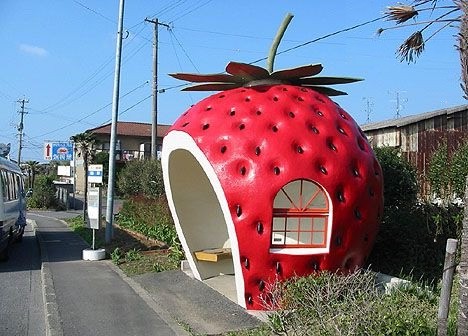 (images via: Art Style Online)
(images via: Art Style Online)
These groovy bus stops from Japan are curiously empty but that just seems to add to their surreal appearance. One might expect the Cat Bus from Miyazaki’s My Neighbor Totoro to pull up and, perhaps, begin nibbling on the shelter for a snack.
Food Building, Toronto, Canada
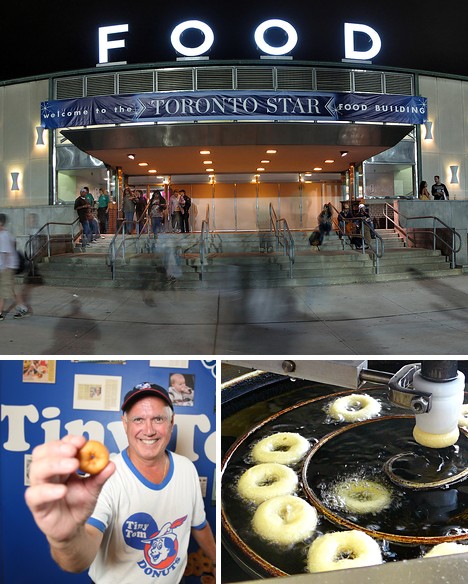 (images via: Ian Muttoo and Toronto Star)
(images via: Ian Muttoo and Toronto Star)
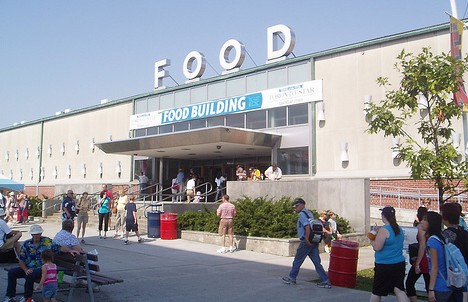 (image via: Toronto Mike)
(image via: Toronto Mike)
Amidst this review of buildings that look like food, one must digress for a moment to celebrate a building that is ABOUT food: The Food Building at the Canadian National Exhibition in Toronto. A summertime fixture, the Food Building at the CNE (or “The Ex” to Hogtowners) is a must-see, must-eat attraction that’s a virtual showcase of tasty treats – and leave your PC nutritional guidelines at the door. By the way, be sure to stop by the Tiny Toms Donuts booth (since 1960) to watch ’em being made and buy a fresh bag to chow down on!
Basket Building, Ohio, USA
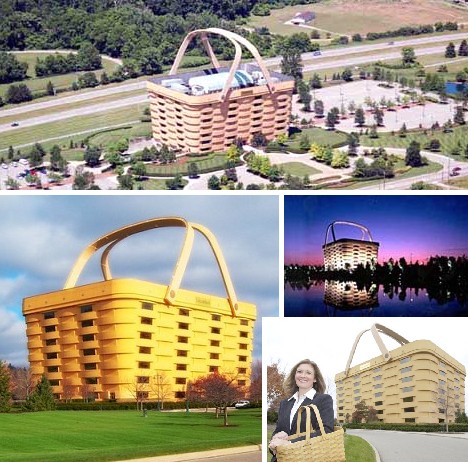 (images via: Longaberger and Vineyard LC)
(images via: Longaberger and Vineyard LC)
Why put up a billboard advertising your company’s wares when your company HQ can perform the same function more interestingly? That’s the philosophy behind The Longaberger Company‘s headquarters building in Newark, Ohio. The family-owned business, likened to the Tupperware of baskets for their corporate and marketing methodology, built a giant, 7-story replica of a Longaberger Medium Market Basket to house their corporate offices and staff.
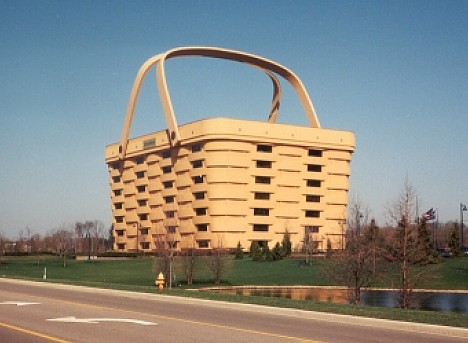 (image via: Bluffton)
(image via: Bluffton)
Maybe the only thing employees working in what is essentially the world’s largest pic-a-nic basket is the arrival of the world’s largest bear.
To paraphrase that old TV tuna commercial, “Sorry Charlie, architects don’t want buildings with good taste, architects want buildings that taste good.” Well, no one will be biting into any of the above structures, unless Godzilla decides to take a bus or Homer Simpson gets hungry for donuts – again. Until then, enjoy these decidedly “tasteful” buildings if you can… just pack a lunch to enjoy afterwards.
